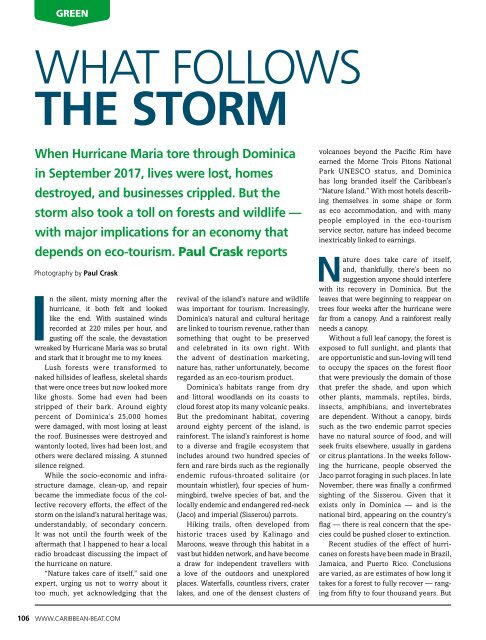Caribbean Beat — January/February 2018 (#149)
A calendar of events; music, film, and book reviews; travel features; people profiles, and much more.
A calendar of events; music, film, and book reviews; travel features; people profiles, and much more.
You also want an ePaper? Increase the reach of your titles
YUMPU automatically turns print PDFs into web optimized ePapers that Google loves.
Green<br />
WhAT follows<br />
the storm<br />
When Hurricane Maria tore through Dominica<br />
in September 2017, lives were lost, homes<br />
destroyed, and businesses crippled. But the<br />
storm also took a toll on forests and wildlife <strong>—</strong><br />
with major implications for an economy that<br />
depends on eco-tourism. Paul Crask reports<br />
Photography by Paul Crask<br />
In the silent, misty morning after the<br />
hurricane, it both felt and looked<br />
like the end. With sustained winds<br />
recorded at 220 miles per hour, and<br />
gusting off the scale, the devastation<br />
wreaked by Hurricane Maria was so brutal<br />
and stark that it brought me to my knees.<br />
Lush forests were transformed to<br />
naked hillsides of leafless, skeletal shards<br />
that were once trees but now looked more<br />
like ghosts. Some had even had been<br />
stripped of their bark. Around eighty<br />
percent of Dominica’s 25,000 homes<br />
were damaged, with most losing at least<br />
the roof. Businesses were destroyed and<br />
wantonly looted, lives had been lost, and<br />
others were declared missing. A stunned<br />
silence reigned.<br />
While the socio-economic and infrastructure<br />
damage, clean-up, and repair<br />
became the immediate focus of the collective<br />
recovery efforts, the effect of the<br />
storm on the island’s natural heritage was,<br />
understandably, of secondary concern.<br />
It was not until the fourth week of the<br />
aftermath that I happened to hear a local<br />
radio broadcast discussing the impact of<br />
the hurricane on nature.<br />
“Nature takes care of itself,” said one<br />
expert, urging us not to worry about it<br />
too much, yet acknowledging that the<br />
revival of the island’s nature and wildlife<br />
was important for tourism. Increasingly,<br />
Dominica’s natural and cultural heritage<br />
are linked to tourism revenue, rather than<br />
something that ought to be preserved<br />
and celebrated in its own right. With<br />
the advent of destination marketing,<br />
nature has, rather unfortunately, become<br />
regarded as an eco-tourism product.<br />
Dominica’s habitats range from dry<br />
and littoral woodlands on its coasts to<br />
cloud forest atop its many volcanic peaks.<br />
But the predominant habitat, covering<br />
around eighty percent of the island, is<br />
rainforest. The island’s rainforest is home<br />
to a diverse and fragile ecosystem that<br />
includes around two hundred species of<br />
fern and rare birds such as the regionally<br />
endemic rufous-throated solitaire (or<br />
mountain whistler), four species of hummingbird,<br />
twelve species of bat, and the<br />
locally endemic and endangered red-neck<br />
(Jaco) and imperial (Sisserou) parrots.<br />
Hiking trails, often developed from<br />
historic traces used by Kalinago and<br />
Maroons, weave through this habitat in a<br />
vast but hidden network, and have become<br />
a draw for independent travellers with<br />
a love of the outdoors and unexplored<br />
places. Waterfalls, countless rivers, crater<br />
lakes, and one of the densest clusters of<br />
volcanoes beyond the Pacific Rim have<br />
earned the Morne Trois Pitons National<br />
Park UNESCO status, and Dominica<br />
has long branded itself the <strong>Caribbean</strong>’s<br />
“Nature Island.” With most hotels describing<br />
themselves in some shape or form<br />
as eco accommodation, and with many<br />
people employed in the eco-tourism<br />
service sector, nature has indeed become<br />
inextricably linked to earnings.<br />
Nature does take care of itself,<br />
and, thankfully, there’s been no<br />
suggestion anyone should interfere<br />
with its recovery in Dominica. But the<br />
leaves that were beginning to reappear on<br />
trees four weeks after the hurricane were<br />
far from a canopy. And a rainforest really<br />
needs a canopy.<br />
Without a full leaf canopy, the forest is<br />
exposed to full sunlight, and plants that<br />
are opportunistic and sun-loving will tend<br />
to occupy the spaces on the forest floor<br />
that were previously the domain of those<br />
that prefer the shade, and upon which<br />
other plants, mammals, reptiles, birds,<br />
insects, amphibians, and invertebrates<br />
are dependent. Without a canopy, birds<br />
such as the two endemic parrot species<br />
have no natural source of food, and will<br />
seek fruits elsewhere, usually in gardens<br />
or citrus plantations. In the weeks following<br />
the hurricane, people observed the<br />
Jaco parrot foraging in such places. In late<br />
November, there was finally a confirmed<br />
sighting of the Sisserou. Given that it<br />
exists only in Dominica <strong>—</strong> and is the<br />
national bird, appearing on the country’s<br />
flag <strong>—</strong> there is real concern that the species<br />
could be pushed closer to extinction.<br />
Recent studies of the effect of hurricanes<br />
on forests have been made in Brazil,<br />
Jamaica, and Puerto Rico. Conclusions<br />
are varied, as are estimates of how long it<br />
takes for a forest to fully recover <strong>—</strong> ranging<br />
from fifty to four thousand years. But<br />
106 WWW.CARIBBEAN-BEAT.COM


















